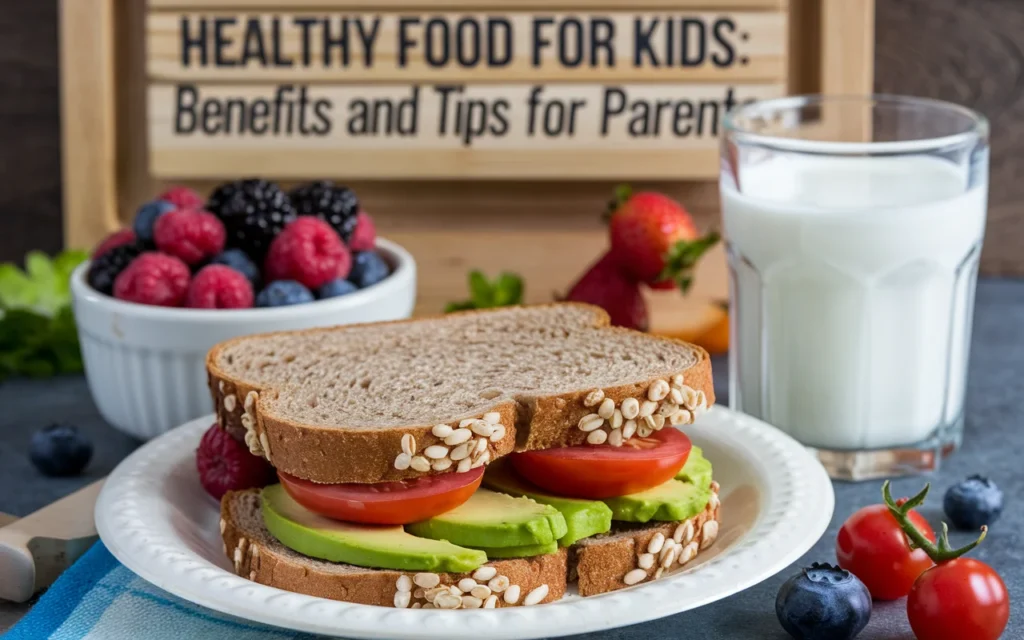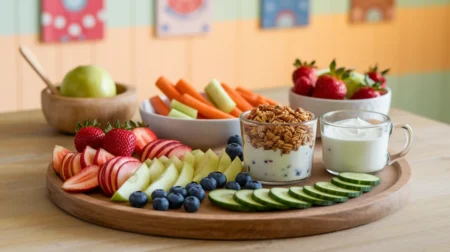benefits of healthy eating for kids
As a parent, you know that providing healthy food for kids is crucial for their growth and development. But with busy schedules and picky eaters, it can be challenging to ensure your children are getting the nutrition they need. That’s why understanding the benefits of a balanced diet for kids and learning practical tips to encourage healthy eating habits is so important for your family’s well-being.
In this article, you’ll discover the key components of a healthy diet for children and strategies to make nutritious meals more appealing. You’ll also learn how to overcome common challenges in kids’ nutrition, create a positive food environment at home, and understand the link between good nutrition and academic performance. By the end, you’ll have the knowledge and tools to help your kids develop healthy eating habits that can last a lifetime.

The Importance of Healthy Eating for Kids
You play a crucial role in shaping your child’s eating habits, which can have a lasting impact on their health and well-being. Providing your kids with the right nutrition is essential for their growth, physical health, and cognitive development.
Nutritional needs for growth
To fuel their growing bodies, children need a variety of nutrients. A balanced diet should include plenty of vegetables, fruits, whole grains, lean proteins, and low-fat dairy [1]. These foods provide essential vitamins, minerals, and dietary fiber that are vital for your child’s development [1].
Impact on physical health
Healthy eating habits can help your child maintain a healthy body weight and reduce the risk of developing conditions like high blood pressure, heart disease, and type 2 diabetes [2]. By encouraging nutritious food choices, you’re setting the foundation for long-term health and reducing the threat of obesity and cardiovascular problems later in life [3].
Effects on cognitive development
Proper nutrition has a significant influence on your child’s brain development and cognitive abilities. Studies have shown a direct relationship between food and cognitive development in the early years of life [4]. A healthy diet rich in essential nutrients can help increase intelligence and improve brain performance [4]. In fact, up to 80% of an adult’s abilities are developed during the first thousand days of life, emphasizing the importance of proper nutrition during this critical period [4].
Key Components of a Healthy Diet for Children
Fruits and Vegetables
You should aim to include a variety of colorful fruits and vegetables in your child’s diet. These provide essential vitamins, minerals, and fiber [5]. Offer fruits and vegetables at every meal and snack time to increase intake . Try to serve 4 to 5 servings per day, as recommended by the USDA and HHS .
Whole Grains
Whole grains are crucial for your child’s diet, providing vital nutrients and lasting energy [7]. Choose foods like whole-wheat bread, brown rice, and oatmeal. Whole grains contain fiber, B vitamins, and minerals that support healthy digestion and lower the risk of illnesses such as heart disease [7].
Lean Proteins
Lean proteins are essential for your child’s growth and development. Include sources like chicken, turkey, fish, beans, and tofu in their diet [8]. These proteins support muscle growth, provide energy, and help maintain a healthy weight [8].
Dairy or Alternatives
Offer your child pasteurized, whole cow’s milk or fortified soy beverages after 12 months of age [9]. These provide important nutrients like calcium and vitamin D. If choosing alternatives, ensure they’re fortified with these essential nutrients [9].
Healthy Fats
Healthy fats are crucial for brain development and hormone production. Include sources like avocados, nuts, seeds, and fatty fish in your child’s diet [10]. For infants and toddlers, 30-40% of their daily calories should come from fat [10].
Strategies for Encouraging Healthy Eating Habits
Be a role model
You play a crucial role in shaping your children’s eating habits. Model eating and enjoying a variety of foods from all food groups. During shared meals, discuss ingredients and their origins. Let your kids see you enjoying healthy foods like crunchy vegetables or fruit and yogurt smoothies. Avoid labeling foods as good or bad, embracing all foods as part of a healthy eating pattern.
Involve kids in meal planning and preparation
Get your children involved in meal planning and shopping. Let them help create a weekly menu and write shopping lists. At the grocery store, allow them to pick new fruits or vegetables to try. In the kitchen, assign age-appropriate tasks like pressing microwave buttons or rinsing vegetables. This involvement helps children feel valued and important, making them more likely to try new foods.
Make healthy foods fun and appealing
Transform meals into fun experiences. Use cookie cutters to create shapes with sandwiches or fruits. Make colorful “rainbow” pizzas using various vegetables. Create parfaits in clear glasses, layering fruits, granola, and yogurt. For a twist, blend their favorite fruits into smoothies. These creative approaches can make healthy eating more exciting and appealing to children.
Limit processed and sugary foods
Reduce ultra-processed foods in your children’s diet, as they often contain added sugars, fats, and salt. On average, sugar makes up 17% of what children consume daily, with half coming from sugary drinks [11]. Opt for water and milk instead of sodas or fruit drinks. Satisfy sweet cravings with whole fruits. Remember, it’s okay to indulge occasionally, following the 80/20 rule: eat intentionally 80% of the time, and have fun with food 20% of the time.
Overcoming Common Challenges in Kids’ Nutrition
Dealing with picky eaters
Picky eating is a common concern among parents. It’s normal for children to go through phases where they’re more selective about food, especially as they assert their independence [12]. To encourage healthy eating habits, avoid forcing your child to clean their plate. Instead, respect their hunger levels and offer a variety of foods. Involve your child in meal planning and preparation to increase their interest in trying new foods [13]. Remember, it may take up to 15 tries for a child to acquire a taste for a new food [13].
Navigating food allergies and intolerances
Food allergies affect approximately 5% of children under five years old [14]. Common allergens include milk, eggs, wheat, soy, tree nuts, peanuts, fish, and shellfish [14]. If you suspect your child has a food allergy, consult with their doctor for proper diagnosis and management. For children with allergies, strict avoidance of trigger foods is crucial [15]. When dining out, communicate clearly with restaurant staff about your child’s allergies and consider using food allergy cards to ensure safe meal preparation [14].
Balancing busy schedules with healthy meals
Planning ahead is key to maintaining healthy eating habits despite busy schedules. Create meal plans, organize shopping lists, and consider preparing double batches of meals to freeze for hectic nights [16]. Involve the whole family in meal preparation to distribute responsibilities and teach valuable life skills [16]. Remember, family meals don’t have to be complicated to be healthy. Focus on balancing meals with starchy carbs, greens, protein, and healthy fats to support your child’s overall well-being [17].
Understanding the Link Between Nutrition and Academic Performance
You might be surprised to learn how closely nutrition and academic performance are linked. Your child’s diet plays a crucial role in their cognitive development and school success. Let’s explore this connection further.
Impact on concentration and memory
Proper nutrition is essential for brain development and function [4]. Micronutrients like iron, zinc, and iodine are particularly important for cognitive development [4]. Iron deficiency, for example, can negatively impact overall intelligence and cognitive development, especially in early childhood [18] [7] [19]. Zinc deficiency is associated with attention and short-term memory problems [18].
Effects on energy levels and mood
The food your child eats directly affects their energy levels and mood. Carbohydrates break down into glucose, the brain’s preferred fuel source. Offering whole grains throughout the day helps maintain steady energy levels, mood, and concentration. Additionally, a healthy gut microbiome, supported by probiotic-rich foods like yogurt, can positively impact mood and energy levels.
Relationship between breakfast and school performance
Breakfast consumption is associated with positive outcomes for diet quality, micronutrient intake, and lifestyle factors. Children who eat breakfast regularly show improved behavior, cognitive function, and school performance [3]. Studies indicate that breakfast foods that don’t create high blood glucose levels after the meal are better at improving students’ intellectual performance [20].
Essential Nutrients for Growing Children
Importance of protein
You need to ensure your child gets enough protein, as it’s crucial for growth, maintenance, and repair of the body [21]. Protein foods also provide essential nutrients like iron, omega-3s, zinc, and B vitamins [21]. Offer protein-rich foods to your child twice daily, or three times if they’re vegetarian [21]. Good sources include lean meat, fish, eggs, dairy, and plant-based options like tofu and legumes [21] [22].
Role of vitamins and minerals
Vitamins and minerals are vital for your child’s growth and development. Vitamin A supports immune function and eye health [23] [2] [1]. B vitamins, especially B12, are essential for brain development [24] [4] [18]. Vitamin C and zinc boost immunity [7] [25]. Iron is crucial for brain function and oxygen transport [26] [27] [28]. Iodine is necessary for growth and tissue development [29].
Significance of omega-3 fatty acids
Omega-3 fatty acids, particularly DHA, are essential for brain health and development in children [30]. They may improve cognitive development, school performance, and help manage conditions like ADHD [30]. The best sources are oily fish like salmon, sardines, and mackerel [30]. For non-fish eaters, consider plant sources like flaxseed or supplements [30].
Calcium and vitamin D for bone health
Calcium and vitamin D are crucial for building strong bones and teeth in children [29] [31]. Vitamin D helps with calcium absorption and immune system responses [31]. Good sources of calcium include dairy products and fortified plant-based alternatives [29]. Vitamin D can be obtained through sunlight exposure and fortified foods [31]. Inadequate intake can lead to rickets and other bone health issues [29] [31].
Creating a Positive Food Environment at Home
Family meals and their benefits
Despite the numerous benefits of family mealtimes, only about 30% of families manage to eat together regularly [32]. Studies show that family dinners can improve physical health, academic performance, and mental well-being [32]. Children who grow up having family dinners tend to eat more healthily and have lower rates of obesity [32]. Regular family meals are also associated with lower rates of depression, anxiety, and substance abuse [32].
Limiting screen time during meals
Screens during mealtimes can lead to unconscious eating, where children are distracted and not fully aware of their food [33]. This can impact their ability to recognize hunger cues and develop healthy associations with food [33]. To reduce screen time, gradually decrease its presence during meals and aim for screen-free family dinners [33].
Offering a variety of healthy options
Provide a wide range of nutritious foods, including fruits, vegetables, whole grains, and lean proteins [34]. This variety ensures your children receive diverse nutrients and helps them develop a taste for different foods [34]. Include at least one or two foods your child likes on the plate to help them feel comfortable, especially when transitioning away from screens [33].
Avoiding food as reward or punishment
Using food as a reward can lead to unhealthy eating habits and potentially increase the risk of obesity [35]. It may cause children to associate eating with emotions unrelated to hunger [35]. Instead, consider non-food rewards and focus on creating positive mealtime experiences through conversation and family interaction [32].
Teaching Kids About Nutrition and Healthy Choices
Age-appropriate nutrition education
You can start teaching your kids about nutrition at an early age. It’s crucial to simplify information to make it understandable for children [36]. Introduce them to MyPlate and the benefits of each food group to promote healthy eating habits [36]. This education can have long-lasting effects, as eating patterns established in childhood often carry into adulthood [36].
Reading food labels together
Get your children comfortable with reading nutrition labels. Practice at home and in the grocery store, asking questions like “How many calories are in a serving?” or “Does this food have fiber in it?” [36]. This familiarizes them with nutrition terminology and helps them make informed choices. Avoid labeling foods as “good” or “bad” to foster a healthy relationship with all foods [36].
Gardening and understanding food sources
Growing your own food is an excellent hands-on way to teach kids about nutrition. It gives you control over every step of the growing process, from seed selection to harvesting [37]. Even with limited space, you can start a windowsill herb garden or grow cherry tomatoes in pots [37]. This activity helps children understand where their food comes from and appreciate fresh produce.
Cooking skills for different age groups
Involve children in age-appropriate cooking activities. Younger kids can start with simple tasks like washing vegetables or mixing ingredients [38]. As they grow older, they can learn more advanced skills such as using a peeler or following recipes [38]. Cooking together not only teaches them about nutrition but also helps develop their motor skills and creativity [38].

The Role of Nutrition in Child Development
Physical growth and development
Nutrition plays a crucial role in your child’s physical growth and development. From conception to age 2, it’s a critical phase where all organs and systems are established [39]. Adequate nutrition, including breastmilk or formula and later nutritious complementary foods, is essential for normal physiological development [40]. For children under 5, malnutrition can lead to delayed development and increased risk of infectious diseases [40]. Nutritional interventions lasting 6 months or more have shown significant improvements in weight-for-height and weight-for-age z scores [41].
Cognitive function and brain health
Proper nutrition is vital for your child’s brain development and cognitive function. Nutrients like iron, zinc, and iodine are particularly important for cognitive development [4]. Iron deficiency, common in infants and young children, can negatively impact overall intelligence and cognitive development [18] [7] [19]. Zinc deficiency is associated with attention and short-term memory problems [18]. Iodine is essential for brain development, and its deficiency is a primary cause of intellectual disability worldwide [18]. Long-chain fatty acids, especially DHA, are crucial for brain growth and development [18].
Emotional well-being and behavior
Nutrition also influences your child’s emotional well-being and behavior. A healthy diet supports gut health, which plays a role in brain function and emotional regulation. Children who eat more nutritious diets, with more fruits and vegetables, have better mental health and wellbeing, which can directly impact anxiety levels and sleep patterns. Family meals are particularly beneficial, with studies showing that eating dinner together at least three times a week can help prevent mental illness in children. It’s a special time to connect emotionally and express interest in each other’s lives.
Building Healthy Eating Habits from an Early Age
You can start building healthy eating habits in your child from an early age. Introducing new foods to infants and toddlers is crucial. Begin offering solid foods when your baby is about 6 months old and shows signs of readiness [42]. Establish regular meal and snack times to create a routine, helping children know what to expect [43]. Encourage self-regulation of food intake by letting your child decide how much to eat [43]. Dealing with food neophobia, or fear of new foods, is common between ages 2 and 7 [44]. Remember, it’s normal for children to be skeptical of unfamiliar foods during this stage.
Balancing Nutrition and Convenience for Busy Families
Quick and healthy meal ideas
You can prepare nutritious meals quickly by using pre-prepped proteins from the grocery store, like shredded chicken or turkey carnitas [40]. One-pot meals are convenient and require minimal cleanup [20]. Plan your weekly meals in advance to avoid the “What should I make for dinner?” dilemma [41]. Keep ingredients for go-to meals on hand and repurpose bulk items for multiple dishes [23].
Smart snacking options
Offer healthy snacks like yogurt, nuts, cottage cheese, and fruit smoothies [2]. Prepare homemade energy balls or banana cookies as nutritious alternatives to commercial snacks [3] [18]. Keep cut fruits and vegetables readily available for quick, healthy snacking options [45].
Meal prepping strategies
Dedicate specific days for meal planning and grocery shopping . Prep ingredients in advance, such as washing and chopping produce on Sundays . Cook extra portions for dinner to use as lunches throughout the week [25]. Consider doing a mid-week meal prep to stay on track [46].
Healthy alternatives to fast food
When eating out, choose healthier fast food options like Panera Bread, Chipotle, or Sweetgreen [41] [2]. These chains offer nutritious salads, bowls, and customizable meals. At home, prepare homemade versions of fast food favorites using healthier ingredients and cooking methods .
Addressing Common Nutritional Concerns in Children
Preventing childhood obesity
Childhood obesity is a growing concern, with approximately 10% of 4-5 year olds being overweight, double the rate from 20 years ago [39]. This trend continues as children age, with at least one in five children aged 6-11 being overweight [39]. Obesity in children can lead to various health issues, including asthma, sleep apnea, and type 2 diabetes [20]. To prevent obesity, focus on providing healthy meals, encouraging physical activity, and limiting screen time [40].
Managing underweight issues
A child is considered underweight if they’re in the bottom 5th percentile for weight compared to their height [39]. Signs of being underweight include declining weight percentiles at pediatrician visits and visible ribs [47]. To address this, incorporate nutrient-rich foods into their diet, such as eggs, nut butters, and full-fat dairy products [40]. Consult a pediatrician if you’re concerned about your child’s weight [20].
Ensuring adequate iron intake
Iron is crucial for children’s growth and development. Infants aged 7-12 months need 11 milligrams of iron daily, while toddlers aged 1-3 years require 7 milligrams [40]. Iron deficiency can affect growth and lead to learning and behavioral problems [41]. To ensure adequate intake, serve iron-rich foods like beef, poultry, beans, and iron-fortified cereals . Pair these with vitamin C-rich foods to enhance absorption [23].
Dealing with food allergies and sensitivities
Food allergies affect approximately 5% of children under five years old [20]. Common allergens include milk, eggs, wheat, soy, tree nuts, peanuts, fish, and shellfish [20]. Symptoms can range from mild to severe, including hives, difficulty breathing, and stomach pains [41]. If you suspect a food allergy, consult your child’s doctor for proper diagnosis and management . For children with allergies, strict avoidance of trigger foods is crucial [2].
The Impact of Diet on Children’s Long-term Health
Your child’s diet plays a crucial role in their long-term health. By establishing healthy eating habits early, you can help reduce the risk of chronic diseases, build strong bones and teeth, support immune function, and set the foundation for lifelong well-being.
Reducing risk of chronic diseases
A balanced diet rich in fruits, vegetables, whole grains, and lean proteins can help prevent obesity, cardiovascular disease, and type 2 diabetes [39]. Encourage your child to eat a variety of colorful fruits and vegetables, which provide essential nutrients and antioxidants .
Building strong bones and teeth
Calcium and vitamin D are vital for bone health. Ensure your child gets enough dairy products, leafy greens, and fortified foods [39]. Weight-bearing exercises like walking and jumping also contribute to stronger bones [1].
Supporting immune function
Foods rich in vitamins A, C, D, and zinc help boost your child’s immune system [41]. Include citrus fruits, sweet potatoes, and almonds in their diet to enhance immune cell function and reduce the risk of infections .
Establishing lifelong eating habits
By modeling healthy eating behaviors and involving your child in meal planning and preparation, you can help them develop positive relationships with food [41]. Limit processed foods and sugary drinks, opting instead for whole, nutrient-dense options .
Navigating Nutrition Challenges in the Modern World
Dealing with food marketing targeted at children
You face a constant barrage of food marketing aimed at your children. Companies spend billions on ads, with 91% promoting unhealthy foods [1]. Children see about 13 food ads daily on TV alone, with 9 out of 10 for high-sugar, high-fat products [20]. Marketing extends beyond TV to digital media, websites, and even schools [48]. To combat this, limit screen time and teach kids to critically evaluate ads.
Managing junk food and sugary drinks
Sugary drinks, including sodas and energy drinks, contribute significantly to children’s calorie intake. In 2005, they were the top calorie source for teens at 226 calories per day . To reduce consumption, limit access to these beverages at home and encourage water or milk instead. When grocery shopping, stick to the perimeter of the store where you’ll find whole foods rather than processed items [47].
Balancing screen time and physical activity
Screen time has increased dramatically, with kids spending more time on digital devices. This often leads to decreased physical activity. The CDC recommends children engage in at least 1 hour of physical activity daily [2]. To achieve this balance, set screen time limits, create tech-free zones in bedrooms, and encourage outdoor play and family activities.
Addressing body image concerns
Body image issues can start as early as age 3, with 40-60% of elementary school girls concerned about their weight . To promote a healthy body image, avoid criticizing your own or others’ appearances, praise qualities unrelated to physical appearance, and teach children that people have value regardless of body shape or size [2]. Consider classroom-based body image programs that address media literacy and self-esteem [1].
Tailoring Nutrition to Different Age Groups
Toddlers and preschoolers
You play a crucial role in shaping your toddler’s eating habits. Offer a variety of foods to ensure adequate nutrition, as children’s needs vary with growth and activity levels [47]. Be patient when introducing new foods, as it may take 8 to 15 attempts for acceptance [47]. Encourage family meals and let your child decide how much to eat [2]. Avoid using food as a reward or punishment [19]. Serve small portions and offer more if needed [4].
School-age children
School-age children need healthy foods and nutritious snacks, eating 4 to 5 times a day [39]. Their food habits are influenced by family, friends, and media [39]. Encourage them to help with meal planning and preparation [41]. Serve meals at the table to avoid distractions . Ensure they get enough calcium, magnesium, potassium, and fiber, as these are often low in children’s diets [3]. Limit screen time to less than 2 hours daily and promote physical activity [24].
Teenagers and their unique needs
Teenagers experience significant growth spurts, increasing their need for calories and nutrients [39]. Girls typically have their growth spurt around 10-11 years, while boys experience it at 12-13 years [40]. Encourage a diet rich in whole grains, fruits, vegetables, lean proteins, and low-fat dairy [20]. Teens should aim for 6 ounces of grains daily . Iron is crucial for both genders, with good sources including lean beef and iron-fortified cereals [23]. Promote 60 minutes of physical activity daily to support overall health [3].
Collaborating with Schools for Better Nutrition
Understanding school lunch programs
School lunch programs play a crucial role in student health and learning. They serve about 32 million student lunches daily during the school year [39]. The National School Lunch Program provides nutritious meals that must meet specific standards, including no more than 30% of calories from fat and less than 10% from saturated fat [20]. These programs are essential for reducing food insecurity and obesity rates among students [47].
Packing healthy lunches and snacks
When packing your child’s lunch, use the Kid’s Healthy Eating Plate as a guide. Focus on variety and quality in food choices. Include a mix of fruits, vegetables, whole grains, and lean proteins. For younger children, opt for finger foods that don’t require utensils. Remember to pack a water bottle for hydration throughout the day [1]. Involve your children in meal prep and let them create their own meals based on healthy options you provide [41].
Advocating for healthier school food options
You can advocate for healthier school food options by joining your school’s wellness committee or writing letters to superintendents and congressional representatives . Support initiatives like the Healthy, Hunger-Free Kids Act of 2010, which calls for local wellness policies that include goals for nutrition education and promotion [47]. Encourage schools to implement nutrition standards for all foods sold on campus, beyond just the federally supported school meals programs [4].
Supporting nutrition education in schools
Nutrition education in schools is crucial but often limited. On average, students receive less than eight hours of nutrition education each school year [47]. You can support nutrition education by encouraging schools to incorporate it across the curriculum. Look for resources like the Let’s Eat Healthy Nutrition Curriculum, which aligns with Common Core State Standards and makes it easy for teachers to include nutrition education in their classrooms [40]. By promoting nutrition education, you can help students make healthier food choices and improve their overall well-being.
Related Topic :
FAQs
What are the top benefits of healthy eating for children?
Healthy eating is crucial for children as it maintains the health of their skin, teeth, and eyes, supports muscle function, and aids in achieving and maintaining a healthy weight. It also strengthens their bones, supports brain development and overall growth, boosts their immune system, and helps their digestive system function properly.
How can parents promote healthy eating habits in their children?
Parents can encourage healthy eating by purchasing and serving a variety of fruits and vegetables, whether fresh, frozen, or canned, and allowing children to pick them out during shopping. It’s advisable to reduce the availability of soft drinks and high-fat or high-calorie snacks like chips, cookies, and candy, offering healthier snack options more frequently instead.
What food safety practices should parents follow?
Parents should adhere to basic food safety practices including using clean utensils and cutting boards when preparing food, especially after handling meat, poultry, and fish. It’s important to store food in airtight, waterproof, and bug-proof containers and to ensure that hot foods stay hot and cold foods stay cold to prevent foodborne illnesses.
How can parents or guardians educate their children about nutrition and the importance of exercise?
To instill good nutrition and exercise habits in children, parents should provide a diet rich in vegetables, fruits, and whole grains, and opt for lean protein sources like meats, poultry, fish, lentils, and beans. Including low-fat or non-fat dairy products and encouraging the family to choose water over sugary drinks are also effective strategies.
References
[1] – https://www.eatright.org/food/planning/meals-and-snacks/nutrition-for-growing-bodies
[2] – https://www.cdc.gov/healthyschools/nutrition/facts.htm
[3] – https://www.ncbi.nlm.nih.gov/pmc/articles/PMC10420931/
[4] – https://www.mapfre.com/en/insights/health/how-eat-affect-cognitive-development-children/
[5] – https://www.betterhealth.vic.gov.au/health/healthyliving/childrens-diet-fruit-and-vegetables
[6] – https://riseandshine.childrensnational.org/increasing-fruits-and-vegetables-in-your-childs-diet/
[7] – https://www.newhorizonacademy.net/importance-wholegrains-children/
[8] – https://easypeasie.com/blogs/peapod-blog/nutritional-focus-the-benefits-of-lean-proteins-for-kids?srsltid=AfmBOoq2SF1zpbcHIKk1H5bVXMf6nhFlOAOiTZtTCyf2TxsUm9ayzUgs
[9] – https://www.cdc.gov/nutrition/infantandtoddlernutrition/foods-and-drinks/cows-milk-and-milk-alternatives.html
[10] – https://elsenutrition.com/a/resources/nutrition/how-to-include-healthy-fats-in-childs-diet?srsltid=AfmBOorzHbXEnJ9E7WEU17b1oH7OCU8t-dYdZ6pGvSeBMCV1LB1PDtIX
[11] – https://www.healthychildren.org/English/healthy-living/nutrition/Pages/How-to-Reduce-Added-Sugar-in-Your-Childs-Diet.aspx
[12] – https://childmind.org/article/how-to-help-kids-who-are-picky-eaters/
[13] – https://www.childrensnebraska.org/10-tips-to-deal-with-picky-eaters/
[14] – https://www.hopkinsmedicine.org/health/conditions-and-diseases/food-allergies-in-children
[15] – https://www.ucsfbenioffchildrens.org/education/managing-food-allergies
[16] – https://eliteclubs.com/tips-healthy-family-meals/
[17] – https://wellnesswithedie.com/how-to-make-healthy-meals-with-a-busy-schedule/
[18] – https://www.nature.com/articles/s41598-023-36841-7
[19] – https://www.aboutkidshealth.ca/role-of-whole-grains-in-a-healthy-diet
[20] – https://www.cdc.gov/nutrition/php/resources/healthy-eating-benefits-for-children.html
[21] – https://www.srnutrition.co.uk/2020/07/the-importance-of-protein-for-childrens-growth/
[22] – https://onceuponafarmorganics.com/blogs/upon-a-blog/protein-for-kids?srsltid=AfmBOoofOvmvMjifEpzjXg8SFA1jWT5Q93IDsH0XaAxauk5NufUQVPRl
[23] – https://www.mayoclinic.org/healthy-lifestyle/childrens-health/in-depth/nutrition-for-kids/art-20049335
[24] – https://www.ncbi.nlm.nih.gov/pmc/articles/PMC8839299/
[25] – https://www.aicr.org/resources/blog/how-to-choose-more-tasty-whole-grains-with-your-kids/
[26] – https://www.cdc.gov/nutrition/infantandtoddlernutrition/vitamins-minerals/index.html
[27] – https://www.healthline.com/nutrition/omega-3-for-kids
[28] – https://www.eatright.org/health/essential-nutrients/fats/do-kids-need-omega-3-fats
[29] – https://raisingchildren.net.au/teens/healthy-lifestyle/nutrients/vitamins-minerals
[30] – https://www.medicalnewstoday.com/articles/omega-3-for-kids
[31] – https://www.hopkinsmedicine.org/health/wellness-and-prevention/vitamin-d-and-calcium
[32] – https://www.gse.harvard.edu/ideas/edcast/20/04/benefit-family-mealtime
[33] – https://www.bespokefamily.co.uk/blog/screentime-and-mealtimes-is-it-ok
[34] – https://www.healthline.com/nutrition/50-super-healthy-foods
[35] – https://www.ncbi.nlm.nih.gov/pmc/articles/PMC7583369/
[36] – https://www.actionforhealthykids.org/activity/how-to-read-nutrition-facts-labels/
[37] – https://foodprint.org/growing-your-own-food/
[38] – https://www.bbcgoodfood.com/howto/guide/guide-cookery-skills-age
[39] – https://www.youtube.com/watch?v=mMHVEFWNLMc
[40] – https://www.healthdirect.gov.au/healthy-eating-for-children
[41] – https://www.nationwidechildrens.org/family-resources-education/700childrens/2021/03/importance-good-nutrition-kids
[42] – https://www.cdc.gov/nutrition/infantandtoddlernutrition/foods-and-drinks/when-to-introduce-solid-foods.html
[43] – https://www.cdc.gov/nutrition/infantandtoddlernutrition/mealtime/mealtime-routines-and-tips.html
[44] – https://www.yummytoddlerfood.com/what-is-neophobia/
[45] – https://www.healthxchange.sg/children/food-nutrition/food-children-fruits-vegetables-important
[46] – https://www.childrens.com/health-wellness/best-sources-of-protein-for-kids
[47] – https://www.helpguide.org/wellness/nutrition/healthy-food-for-kids
[48] – https://www.apa.org/topics/children/healthy-eating










